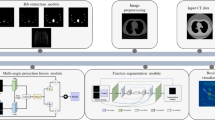Abstract
Purpose
More than 70 million computed tomography scans are made per year. A great number of them aim at the thoraxic region, due to the number of organs and structures within it. The 3D visualization of these structures, including the bone, can lead to a more precise medical diagnosis. There are a number of works regarding 3D bone reconstruction, but most fail to present a quantitative evaluation of their assessment or have not achieved an assessment close to 100%. We present an automatic method of bone segmentation followed by 3D reconstruction that approaches these current limitations.
Methods
The proposed methodology has three blocks: (1) Preprocessing, whereby a median filter was applied to images that presented a high level of noise; (2) feature extraction procedure, in which (i) the images intensity levels were converted to attenuation coefficients and (ii) a (MLP) neural network was used to populate the Space of Attributes with the corresponding feature vectors; and (3) 3D structural construction, whereby a red-and-black tree with graph guidance combined the regarding clustered feature vectors with their spatial neighbors. To evaluate the results, the accuracy between the 2D-segmented images and their corresponding gold standards was calculated.
Results
The material is composed of a set of 90 CT chest volumes. We obtained high accuracy parameters, such as Overlap Dice (%) = 98.77 ± 0.58 and False Negative (%) = 0.13 ± 0.026.
Conclusion
The proposed methodology presented significant accuracy values and processing time, having a large database to test the methodology, besides being a fully automatic method of 3D bone reconstruction.







Similar content being viewed by others
References
Allisy-Roberts P, Williams J. Farr’s physics for medical imaging. 2nd ed. USA: Elsevier; 2008.
Aminoff MJ, Boller F, Swaab DF. Handbook of clinical neurology. USA: Elsevier; 2002.
Armato SG 3rd, McLennan G, Bidaut L, McNitt-Gray MF, Meyer CR, Reeves AP, et al. The lung image database consortium (LIDC) and image database resource initiative (IDRI): a completed reference database of lung nodules on CT scans. Med Phys. 2011;38(2):915–31.
Auer R, Riehl J. The incidence of deep vein thrombosis and pulmonary embolism after fracture of the tibia: An analysis of the National Trauma Databank. J Clin Orthop Trauma. 2017;8(1):38–44.
Bondy A, Murty USR. Graph theory. 1st ed. London: Springer; 2007.
Calder J, Tahmasebi AM. A variational approach to bone segmentation in CT images. Proc SPIE Int Soc Opt Eng. 2011;7962(3):346–54.
Cormem TH, Leiserson CE, Rivest RL, Stein C. Introduction to algorithms. 3rd ed. England: The MIT Press; 2009.
Dice LR. Measures of the amount of ecologic association between species. Ecology. 1945;26(3):297–302.
Drumond DAF, Abranates WL. Tipos de trauma – o politraumatizado. In: Freire E. (Org.). Trauma: a doença dos séculos. São Paulo: Atheneu; 2001. p. 451–59.
Ferraz Jr. SUS gasta R$ 4 milhões para atender acidentados em um ano. Jornal da USP. 2018. https://jornal.usp.br/atualidades/sus-gasta-r-4-milhoes-para-atender-acidentados-em-um-ano/. Accessed in 09 Jan 2019.
Florence L, Córdova LA, Pajarinen J, Lin T, Yao Z, Goodman SB. Inflammation, fracture and bone repair. Bone. 2016;86:119–30.
Freitas MB. Panorama das Exposições Médicas em Radiologia Convencional no Estado de São Paulo. PhD [thesis]. São Paulo: Universidade Federal de São Paulo. 2005.
Gardner MW, Dorling SR. Artificial neural networks (the multilayer perceptron) - a review of applications in the atmospheric sciences. Atmos Environ. 1998;32(14–15):2627–36.
González BA, Mahesh M, Kim KP, Bhargavan M, Lewis R, Mettler F, et al. Projected cancer risks from computed tomographic scans performed in the United States in 2007. Arch Intern Med. 2007;169(22):2071–7.
Haykin S. Neural networks and learning machines. 3rd ed. Hamilton: Pearson Prentice Hall; 2009.
Huang L, Qiu Z, Song Z. 3D reconstruction and visualization from 2D CT images. IEEE. 2011;2(1):153–7.
Kamencay P, Zachariasova M, Hudec R, Benco M, Radil R. 3D image reconstruction from 2D CT slices. IEEE. 2014;1(1):1–4.
Kareliotis G. Study of kVp and mAs effect on radiation dose and image quality in computed tomography. Master [thesis]. Greece: National Technical University of Athens; 2015.
Kupinsk MA, Giger ML. Automated seeded lesion segmentation on digital mammograms. IEEE Trans Med Imaging. 1998;17(4):510–7.
Marder VJ, Aird WC, Bennett JS, Chulman S, White GC II. Hemostasis and thrombosis: basic principles and clinical practice. 6th ed. USA: Lippincott William & Wilkins; 2012.
Nakajima Y, Yamada K, Imamura K. Radiologist supply and workload: international comparison--working Group of Japanese College of Radiology. Radiat Med. 2008;26(8):455–65.
Rezende SO. Sistemas Inteligentes: Fundamentos e Aplicações. Barueri: Manole; 2003.
Russo P. Handbook of X-ray imaging: physics and technology. 1st ed. London: CRC Press; 2018.
Schmid GL, Lippmann S, Unverzagt S, Hofmann C, Deutsch T, Frese T. The investigation of suspected fracture - a comparison of ultrasound with conventional imaging. Dtsch Arztebl Int. 2017;114(45):757–64.
Shadid WG, Willis A. Bone fragment segmentation from 3D CT imagery. Comput Med Imaging Graph. 2018;66(1):14–27.
Singh G, Neeraj S. 3-D visualization techniques for medical images: a comprehensive study. IJIRCCE. 2016;4(7):14321–4.
Udupa JK, Leblanc VR, Zhuge Y, Imielinska C, Schmidt H, Currie LM, et al. A framework for evaluating image segmentation algorithms. Comput Med Imaging Graph. 2006;30(2):75–87.
Wirth N. Algorithms + data structures = programs. USA: Prentice Hall PTR; 1978.
Zhao B, Ding H, Lu Y, Wang G, Zhao J, Molloi S. Dual-dictionary learning-based iterative image reconstruction for spectral computed tomography application. Phys Med Biol. 2012;57(24):8217–29.
Acknowledgements
The authors acknowledge the Coordination for the Improvement of Higher Education Personnel (CAPES), Laboratory of Image and Signal Processing of the Institute of Science and Technology of UNIFESP (LaPIS-ICT-UNIFESP), the Trauma Team of the Municipal Hospital of São José dos Campus under the coordination of Physician Luciano Guedes Jorge, and The unknown reviewers, who have made important contributions to this work.
Author information
Authors and Affiliations
Corresponding author
Additional information
Publisher’s note
Springer Nature remains neutral with regard to jurisdictional claims in published maps and institutional affiliations.
Rights and permissions
About this article
Cite this article
Sais, B.T., Vital, D.A. & Moraes, M.C. Robust 3D reconstruction of rib cage bones in computed tomography images, by combining knowledge from radiological, machine learning, and innovative graph guidance. Res. Biomed. Eng. 35, 45–56 (2019). https://doi.org/10.1007/s42600-019-00008-z
Received:
Accepted:
Published:
Issue Date:
DOI: https://doi.org/10.1007/s42600-019-00008-z




